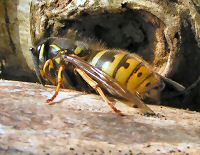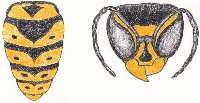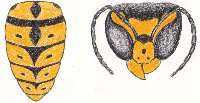This is a feature summary. If you would like to read the full text, click here.Wasps: friend or foe?
Re-evaluating our own attitudes towards animals and plants normally regarded as pests is part of the fun of wildlife gardening. Wasps are typically regarded with apprehension, or even fear, by most people. It often comes as a surprise to find out that they perform a useful, even vital, role in nature.
Wasps I have known: a personal account
 Queen common wasp.
Nearly everyone can recount a tale of being on the wrong end of an angry wasp and I'm no exception. When I was a boy, I tried to kill any wasp that came near me. As I grew older and wiser I tried to avoid them instead, but still I regarded them as nothing more than a nuisance. Then my interest in wildlife gardening prompted me to find out more about these 'pests' and the result is that I'm now fascinated by them.
Queen common wasp.
Nearly everyone can recount a tale of being on the wrong end of an angry wasp and I'm no exception. When I was a boy, I tried to kill any wasp that came near me. As I grew older and wiser I tried to avoid them instead, but still I regarded them as nothing more than a nuisance. Then my interest in wildlife gardening prompted me to find out more about these 'pests' and the result is that I'm now fascinated by them.
A wasp is a wasp is a wasp?
The large black and yellow banded insects which we call wasps are more correctly referred to as 'social wasps' and there are about nine species in Britain (though more species from the continent are being found here as the climate warms up). Very generally speaking, two of these are more likely to be encountered than the others: they are the common wasp and the german wasp. (This is particularly true in the south of the country, but as you go northwards, you may be just as likely to see the norwegian wasp.) The common and german wasps can be separated from each other (and the other species) by the pattern of yellow and black bands on their abdomens (their 'tail ends') and the patterns on their faces.
The most common wasps
These pictures should help you to tell apart two of the most common British wasps.
 | | Common wasp. Note the 'bell' or 'anchor' shaped black marking on the face. |
|  | | German wasp. The 'bell' of the common wasp is replaced by three black dots, though this is variable. Sometimes the two smaller dots are hard to see. |
|
What are wasps for?
Social wasps have a fascinating life cycle. The mated female ('queen') hibernates through the winter in a secluded spot. Then in spring she builds a nest out of paper made by chewing up wood and lays eggs in papery cells. When these eggs hatch into larvae (grubs) she feeds them on other animals (often insects) which she catches and kills. The first generation of wasps mature as sterile females ('workers') which immediately assist the queen to feed and nurture successive generations from eggs that are all laid by the queen (again these all mature into workers).
It is a little appreciated fact that while the colony is growing in this way, the workers hunt and kill vast numbers of other insects (often garden 'pests') to feed the young back at the nest; thus they play a vital role in maintaining a stable garden ecosystem.
Towards the end of the summer the queen produces a generation of wasps which mature into males ('drones') and females (young 'queens'). These leave the nest and mate (often with members of other colonies). Eventually the males and workers die and the mated queen finds a place to spend the winter - starting the cycle again.
Whilst the workers feed the young on meat, they themselves eat nectar and a sugary secretion produced by the grubs. In the late summer, once the colony is no longer producing young wasps, the remaining workers often try to satisfy their sweet tooth from alternative sources, e.g. our picnics! It's generally only during this very limited period that they become a nuisance to us.
Making friends with a wasp
Male wasps are incapable of stinging: only workers and fertile females ('queens') can sting. Instinct only tells a wasp to sting in self-defence or in the defence of the nest, so under normal circumstances, a wasp is very unlikely to sting you. If you find yourself close to a nest, you should retreat and try to avoid sudden movements. Away from the nest a wasp is only likely to sting you if you trap it in some way e.g. by putting your hand on it or if it flies under your clothing before you see it. Generally speaking, once you've spotted a wasp away from its nest, you are extremely unlikely to be stung by it and you can observe them with confidence.
For most people a wasp sting is a bit painful but not dangerous: usually only a local reaction around the sting site occurs. If a more widespread reaction develops and for stings in dangerous areas (e.g. the throat), medical attention should be sought.
| First published January 2003. Last revised December 2004. |
|
Copyright Richard Burkmar 2003. Permission is hereby granted for anyone to use this article for non-commercial purposes which are of benefit to the natural environment as long the original author is credited. School pupils, students, teachers and educators are invited to use the article freely. Use for commercial purposes is prohibited unless permission is obtained from the copyright holder. |
This is a feature summary. If you would like to read the full text, click here.